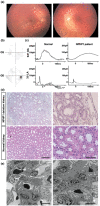Defective INPP5E distribution in NPHP1-related Senior-Loken syndrome
- PMID: 33306870
- PMCID: PMC7963418
- DOI: 10.1002/mgg3.1566
Defective INPP5E distribution in NPHP1-related Senior-Loken syndrome
Abstract
Background: Senior-Loken syndrome is a rare genetic disorder that presents with nephronophthisis and retinal degeneration, leading to end-stage renal disease and progressive blindness. The most frequent cause of juvenile nephronophthisis is a mutation in the nephronophthisis type 1 (NPHP1) gene. NPHP1 encodes the protein nephrocystin-1, which functions at the transition zone (TZ) of primary cilia.
Methods: We report a 9-year-old Senior-Loken syndrome boy with NPHP1 deletion, who presents with bilateral vision decrease and cystic renal disease. Renal function deteriorated to require bilateral nephrectomy and renal transplant. We performed immunohistochemistry, H&E staining, and electron microscopy on the renal sample to determine the subcellular distribution of ciliary proteins in the absence of NPHP1.
Results: Immunohistochemistry and electron microscopy of the resected kidney showed disorganized cystic structures with loss of cilia in renal tubules. Phosphoinositides have been recently recognized as critical components of the ciliary membrane and immunostaining of kidney sections for phosphoinositide 5-phosphatase, INPP5E, showed loss of staining compared to healthy control. Ophthalmic examination showed decreased electroretinogram consistent with early retinal degeneration.
Conclusion: The decreased expression of INPP5E specifically in the primary cilium, coupled with disorganized cilia morphology, suggests a novel role of NPHP1 that it is involved in regulating ciliary phosphoinositide composition in the ciliary membrane of renal tubular cells.
Keywords: INPP5E; NPHP1; Senior-Loken syndrome; primary cilia; transition zone.
© 2020 The Authors. Molecular Genetics & Genomic Medicine published by Wiley Periodicals LLC.
Conflict of interest statement
The authors declare no financial/non‐financial competing interest.
Figures


Similar articles
-
Clinical and Genetic Characteristics of Senior-Loken Syndrome Patients in Korea.Genes (Basel). 2025 Jul 17;16(7):835. doi: 10.3390/genes16070835. Genes (Basel). 2025. PMID: 40725491 Free PMC article.
-
Ciliopathies and the Kidney: A Review.Am J Kidney Dis. 2021 Mar;77(3):410-419. doi: 10.1053/j.ajkd.2020.08.012. Epub 2020 Oct 9. Am J Kidney Dis. 2021. PMID: 33039432 Review.
-
Molecular Study of Nephronophthisis in 7 Unrelated Pakistani Families.Iran J Kidney Dis. 2018 Jul;12(4):240-242. Iran J Kidney Dis. 2018. PMID: 30087219
-
Ciliopathy-associated IQCB1/NPHP5 protein is required for mouse photoreceptor outer segment formation.FASEB J. 2016 Oct;30(10):3400-3412. doi: 10.1096/fj.201600511R. Epub 2016 Jun 21. FASEB J. 2016. PMID: 27328943 Free PMC article.
-
Senior-Løken syndrome: a syndromic form of retinal dystrophy associated with nephronophthisis.Vision Res. 2012 Dec 15;75:88-97. doi: 10.1016/j.visres.2012.07.003. Epub 2012 Jul 20. Vision Res. 2012. PMID: 22819833 Free PMC article. Review.
Cited by
-
Clinical and Genetic Characteristics of Senior-Loken Syndrome Patients in Korea.Genes (Basel). 2025 Jul 17;16(7):835. doi: 10.3390/genes16070835. Genes (Basel). 2025. PMID: 40725491 Free PMC article.
-
Potential Therapeutic Targets for Olfactory Dysfunction in Ciliopathies Beyond Single-Gene Replacement.Chem Senses. 2021 Jan 1;46:bjab010. doi: 10.1093/chemse/bjab010. Chem Senses. 2021. PMID: 33690843 Free PMC article. Review.
-
Compartmentalized ciliation changes of oligodendrocytes in aged mouse optic nerve.J Neurosci Res. 2024 Jan;102(1):e25273. doi: 10.1002/jnr.25273. J Neurosci Res. 2024. PMID: 38284846 Free PMC article.
-
Composition, organization and mechanisms of the transition zone, a gate for the cilium.EMBO Rep. 2022 Dec 6;23(12):e55420. doi: 10.15252/embr.202255420. Epub 2022 Nov 21. EMBO Rep. 2022. PMID: 36408840 Free PMC article. Review.
-
Patient-derived and gene-edited pluripotent stem cells lacking NPHP1 recapitulate juvenile nephronophthisis in abnormalities of primary cilia and renal cyst formation.Front Cell Dev Biol. 2024 Jun 26;12:1370723. doi: 10.3389/fcell.2024.1370723. eCollection 2024. Front Cell Dev Biol. 2024. PMID: 38989059 Free PMC article.
References
-
- Awata, J. , Takada, S. , Standley, C. , Lechtreck, K. F. , Bellve, K. D. , Pazour, G. J. , Fogarty, K. E. , & Witman, G. B. (2014). NPHP4 controls ciliary trafficking of membrane proteins and large soluble proteins at the transition zone. Journal of Cell Science, 127(Pt 21), 4714–4727. 10.1242/jcs.155275 - DOI - PMC - PubMed
Publication types
MeSH terms
Substances
Supplementary concepts
Grants and funding
LinkOut - more resources
Full Text Sources
Medical

